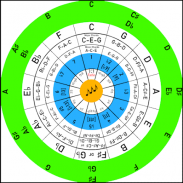






Circle of fifths +
Maikstrings
Description of Circle of fifths +
কুইন্ট বৃত্ত হল একটি চিত্র যা সঙ্গীতের চাবিগুলির মধ্যে সম্পর্ক দেখায়। এটি আপনাকে একটি চাবির দুর্ঘটনা, দাঁড়িপাল্লা এবং জ্যা নির্ধারণ করতে সাহায্য করতে পারে। এখানে 10টি পয়েন্ট রয়েছে যা কুইন্ট বৃত্তটিকে সহজে এবং বোধগম্যভাবে ব্যাখ্যা করে:
কুইন্ট বৃত্তে প্রধান কীগুলির জন্য একটি বাইরের বৃত্ত এবং ছোট কীগুলির জন্য একটি অভ্যন্তরীণ বৃত্ত থাকে।
সমান্তরাল প্রধান এবং ছোট কীগুলির একই দুর্ঘটনা রয়েছে এবং কুইন্ট বৃত্তে সারিবদ্ধ।
C মেজর কী এবং একটি মাইনর কী-এর কোনো দুর্ঘটনা নেই এবং কুইন্ট বৃত্তের শীর্ষে রয়েছে।
আপনি যদি C প্রধান ঘড়ির কাঁটার থেকে ডানদিকে যান, আপনি তীক্ষ্ণ দুর্ঘটনা (#) সহ চাবিগুলি পাবেন। আপনি যখন কুইন্ট বৃত্তে এক অবস্থানে চলে যান তখন শার্পের সংখ্যা এক দ্বারা বৃদ্ধি পায়।
আপনি C প্রধান থেকে ঘড়ির কাঁটার বিপরীত দিকে বাম দিকে সরে গেলে, আপনি ফ্ল্যাট অ্যাক্সিডেন্টাল (♭) সহ চাবিগুলি পাবেন। আপনি যখন কুইন্ট বৃত্তে এক অবস্থানে যান তখন ফ্ল্যাটের সংখ্যা এক দ্বারা বৃদ্ধি পায়।
কুইন্ট বৃত্তের চাবিগুলি প্রতিটি পঞ্চমাংশের ব্যবধানে। একটি পঞ্চম হল একটি বড় বা ছোট স্কেলে পাঁচটি টোনের দূরত্ব।
তীক্ষ্ণ দুর্ঘটনার সাথে চাবিগুলির ক্রম মনে রাখার জন্য, আপনি নিম্নলিখিত স্মৃতিবিদ্যা ব্যবহার করতে পারেন: Geh du alter Esel hole Fisch. প্রাথমিক অক্ষরগুলি কীগুলি দেয়: G major, D major, A major, E major, B major, F sharp major.
ফ্ল্যাট দুর্ঘটনার সাথে চাবিগুলির ক্রম মনে রাখতে, আপনি নিম্নলিখিত স্মৃতিচিহ্ন ব্যবহার করতে পারেন: Frische Brötchen essen Asse des Gesangs. প্রাথমিক অক্ষরগুলি কীগুলি দেয়: F মেজর, বি ফ্ল্যাট মেজর, ই ফ্ল্যাট মেজর, এ ফ্ল্যাট মেজর, ডি ফ্ল্যাট মেজর, জি ফ্ল্যাট মেজর৷
তীক্ষ্ণ দুর্ঘটনার সাথে একটি প্রধান কী-এর মূল নোট খুঁজে পেতে, আপনি শেষ তীক্ষ্ণ দুর্ঘটনাজনিত থেকে একটি সেমিটোন দিয়ে উপরে যেতে পারেন। উদাহরণস্বরূপ, E হল A মেজরের শেষ তীক্ষ্ণ দুর্ঘটনা। আপনি যদি E থেকে একটি সেমিটোন দিয়ে উপরে যান, আপনি A-তে পৌঁছাবেন।
ফ্ল্যাট অ্যাকসিডেন্টাল সহ একটি প্রধান কী-এর মূল নোট খুঁজে পেতে, আপনি শেষ পর্যন্ত ফ্ল্যাট অ্যাক্সিডেন্টাল নিতে পারেন। উদাহরণস্বরূপ, E ফ্ল্যাট মেজর-এ একটি ফ্ল্যাট হল উপান্তর সমতল দুর্ঘটনা। একটি ফ্ল্যাট তাই E ফ্ল্যাট মেজরের মূল নোট।
আমি আশা করি এই পয়েন্টগুলি আপনাকে কুইন্ট বৃত্তটি আরও ভালভাবে বুঝতে সাহায্য করেছে।























